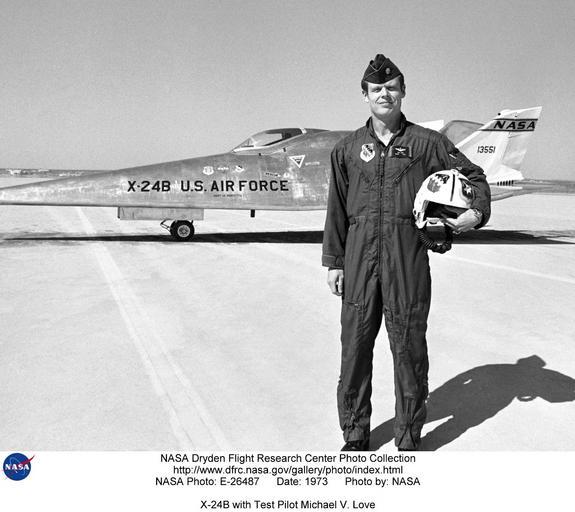MAKE A MEME
View Large Image

| View Original: | X-24B_with_Test_Pilot_Michael_V._Love_DVIDS717276.jpg (1536x1367) | |||
| Download: | Original | Medium | Small | Thumb |
| Courtesy of: | commons.wikimedia.org | More Like This | ||
| Keywords: X-24B with Test Pilot Michael V. Love DVIDS717276.jpg en This photo shows Air Force Lieutenant Colonel Michael V Love in front of the X-24B lifting-body research vehicle at Edwards Air Force Base in 1973 Love was assigned as a project pilot on the joint NASA-USAF X-24B Lifting Body flight test program at the NASA Flight Research Center He made a total of 12 flights in the plane from October 4 1973 until July 15 1975 Love flew it to a speed of Mach 1 76 on October 25 1974 a record for the X-24B Love attended the USAF Test Pilot School and remained as an instructor there from 1969 through 1971 He was a test pilot at Edwards when assigned to fly to the X-24B Love was a combat veteran of Vietnam and was awarded the Distinguished Flying Cross with two Oak Leaf clusters Love perished while attempting an emergency landing in an RF-4C on March 1 1976 The X-24B was the last aircraft to fly in the Dryden Flight Research Center's manned lifting body program The X-24 was one of a group of lifting bodies flown by the NASA Flight Research Center now Dryden Flight Research Center Edwards California in a joint program with the U S Air Force at Edwards Air Force Base from 1963 to 1975 The lifting bodies were used to demonstrate the ability of pilots to maneuver and safely land wingless vehicles designed to fly back to Earth from space and be landed like an airplane at a predetermined site Lifting bodies' aerodynamic lift essential to flight in the atmosphere was obtained from their shape The addition of fins and control surfaces allowed the pilots to stabilize and control the vehicles and regulate their flight paths Built by Martin Aircraft Company Maryland for the U S Air Force the X-24A was a bulbous vehicle shaped like a teardrop with three vertical fins at the rear for directional control It weighed 6 270 pounds was 24 5 feet long and 11 5 feet wide measuring just the fuselage not the distance between the tips of the outboard fins Its first unpowered glide flight was on April 17 1969 with Air Force Maj Jerauld Gentry at the controls Gentry also piloted its first powered flight on March 19 1970 The X-24A was flown 28 times in the program that like the HL-10 validated the concept that a Space Shuttle vehicle could be landed unpowered The fastest speed achieved by the X-24A was 1 036 miles per hour mph--Mach 1 6 Its maximum altitude was 71 400 feet It was powered by an XLR-11 rocket engine with a maximum theoretical vacuum thrust of 8 480 pounds The X-24A was later modified into the X-24B The bulbous shape of the X-24A was converted into a flying flatiron shape with a rounded top flat bottom and double delta platform that ended in a pointed nose The X-24B demonstrated that accurate unpowered reentry vehicle landings were operationally feasible Top speed achieved by the X-24B was 1 164 mph and the highest altitude it reached was 74 130 feet The vehicle is on display at the Air Force Museum Wright-Patterson Air Force Base Ohio The pilot on the last powered flight of the X-24B was Bill Dana who also flew the last X-15 flight about seven years earlier The X-24A shape was later borrowed for the X-38 Crew Return Vehicle CRV technology demonstrator for the International Space Station The X-24B is on public display at the Air Force Museum Wright-Patterson AFB Ohio NASA Identifier NIX-E-26487 2009-12-09 Glenn Research Center https //www dvidshub net/image/717276 717276 2012-10-10 18 18 WASHINGTON DC US PD-USGov Aircraft at Rogers Dry Lake Images from DoD uploaded by Fæ Martin-Marietta X-24 | ||||